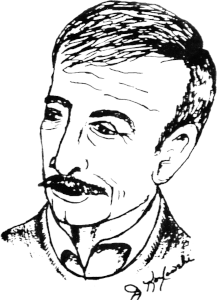Early settler and one of the ‘Seven Pillars’
Hailing from Aylsebury, England, William Fowler was a Puritan seeking to escape the repression of Charles the 1st and the established Anglican Church. Puritan leader Reverend Davenport's party sailed in May 1637 from London to Boston Aboard the "Hector." They would be joined by a second group hailing mostly from Hertfordshire sailing from London five months later led by Rev. Peter Prudden. William Fowler was among this group. All were welcomed and invited to stay in Massachusetts, but the two Reverends sought to establish their own colony and with God's help, find their piece of heaven on earth. A group led by Theophilus Eaton, Davenport's co-leader from England, scouted the south shores of New England looking for a suitable site. They found the headwaters of the Quinnipiac in an area then known as Red Mount. A party of nine was left to hold the claim and a report was sent back to Boston with the bulk of the party. The balance of the Prudden and Davenport parties sailed there the following spring, 1638 founding the Colony of New Haven.
Eventually friction arose between the two reverends even though Prudden's English immigrants, of whom Fowler was one, had their own area of the Town known as the Hertford section. Prudden was quite the inspiring preacher and acquired many followers from among the previously settled in the Boston area and Wethersfield, then still part of Massachusetts Colony. One such recruit was Sgt. Thomas Tibbals, who from his experience in the Pequot War, suggested the Wepawaug area as a suitable place to retire the community. Fowler and several men went to scout the area with Sgt Tibbals and found it suitable.
Fowler also was among the group which on February 12, 1639 met with the Indian Sachem Ansantawae (2008 Hall of Fame Inductee) to purchase the land from the East River to the Housatonic including "Charles Island" and north to Derby encompassing nearly all of present day Milford, Orange and parts of Woodbridge. The East River is now known as the Indian River. Ansantawae and his people remaining south of it on the ridge overlooking Bayview and other beaches. Later Purchases expanded the community even further.
Back at New Haven, the Prudden party met at Robert Newman's Barn on august 22, 1639 to found the First Church. William Fowler, reportedly a learned gentleman, was chosen to be one of the "seven pillars" responsible for selecting and approving the membership which would move to the new colony. The bulk of the party, then still living in New Haven, followed Sgt Tibbals through the woods on winding Indian trails with its animals, food and personal possessions. Bulky items, farm and personal utensils and the pre fabricated frame work for the common house was transported by sea. Little more than moving, building the common house and settling down was accomplished at the end of summer and fall of that year.
On November 20, 1639 at Milford, the settlers met in the first Court, choosing William Fowler as one of their six judges. Judges were more than judicial officials during those days as they also served a legislative duty in choosing the direction, rules and purposes of he community. Forty four free planters were acknowledged and nine others added to the rolls of the settlement that day in preparation for the work that would be done the following spring.
A second Court was held in March 1640 and the need for the grinding of grain addressed. William Fowler and his family was tasked with the duty to build the mill. Land along the Wepawaug river rapids at today's Memorial Bridge and Fowler building was allotted to him for this purpose. He and his family had to dam the river, build a culvert, obtain, move and manufacture the grinding stones, build the mill and go into operation and do it all promptly enough that he could retain his concession. They did.
The Town, actually then a church society, retained the right to buy out his operation. Apparently fully satisfied, they never did. The judges of the common court set his wages for milling: three quarts of raw grain for every bushel brought to mill.
Fowler would soon add a saw mill which must have been very successful. In the years that followed, so much wood was taken out of the native forests for shipment back to England that the town had to embargo lumber exports for a time out of fear it would not have enough for its local needs.
The Mills remained in operation by the Fowler family until 1887; nearly two and half centuries. Of the early Fowler family, brother John Fowler was listed in the Lambert 1838 History of New Haven County as a founding person but not a free planter. He does not show up in early Milford records, but his home is listed on the 1646 of the town as does the Home of William near the Mill site.
William Fowler would go on to help found the city of Newark, NJ, with other pious members of the Branford and Milford societies. He would return to Milford and many generations still resided in the area.



